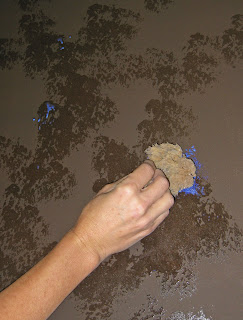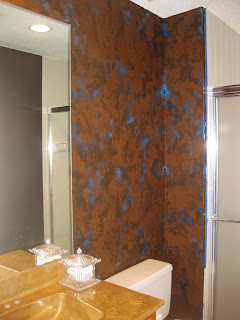Who said Monday has to be blue? Let's get our shine on shall we!
Our product line, Faux Effects, offers five different waxes with different sheens and application properties. Most are appropriate for a variety of surfaces and one, Master Finishing Wax, is specific to cabinetry. Before I get into the different waxes, let's go over why you would select a wax in the first place.
Waxes in faux finishing accomplish several things. They offer a translucent to semi-opaque medium for adding a decorative layer to your finish.
(Faux Color mixed with Aquawax and troweled over Brown Sapphire Venetian Gem plaster)
Because of the thickness of wax compared to glaze mediums, wax will hold everything from colorants, mica powders, glitter and beads-often in a trowelable form.
(Aquawax with Silver Glitter over Foil and Lusterstones)
Waxes are an appropriate choice when you want to smooth a finish or fill in voids but still see the layers underneath. For example, Ashley and I completed a Lusterstone project in a loft that was long and narrow. The single natural light source was a large window at the end of the "shoebox" space. If the light was behind you or you stood in front of the finish, the walls appeared smooth. But when you entered the space with only the natural light source, the wall application appeared uneven. Our solution was to trowel a thin coat of O'Villa Wax. This "smoothed" the appearance of the surface but did not change the depth or color of the original Lusterstone technique.
(Combed Softex back filled and smoothed with O'Villa Wax mixed with pearl mica powder.)
Waxes may also be used as the finish medium and do not have to be layered with other products.
(Layers of tinted Aquawax)
Finally, many waxes are a topcoat adding a protective and decorative layer to your finishes in one step.
Waxes are particularly effective in wet areas such as kitchens and bathrooms or in children's rooms where scrubbing is a priority.
(Custom tinted O'Villa Plaster with O'Villa Wax in a young boy's room)
So what are the Faux Effects Wax options?
The first wax is a Silver Label product, Aquawax. This acrylic wax is translucent in nature and may be tinted with a variety of colorants and mica powders. It dries to a shiny sheen therefore it tends to look more contemporary.
(Aquawax mixed with metallics and Verdigris Colors)
Aquawax is a great choice for ceilings where you often want greater light reflection.
(Gold tinted Aquawax over Venetian Gem Plaster and Palette Deco)
It is a good medium for holding glitters but may fog if you are trying to create a build thick enough to hold glass beads.
(Aquawax and silver glitter over a Wallovers Stencil)
It will also fog (white areas) if troweled thickly over a dark surface. Building your finish with thin layers is a better approach. Aquawax dries quickly so multiple layers in a single day are easily accomplished. Because it is thin in nature, it is a nice choice when you don't want to bury your previous layers.
(Aquawax mixed with MetalGlow over Sandstone)
Aquawax is considered a troweled product. Because it dries fast, it is difficult to brush over a large surface. I have thinned tinted Aquawax with So-Slow for a contemporary furniture finish that I am developing for a metallic cabinetry class.
(Aquawax mixed with colorants and So-Slow over a metallic base coat)
Faux Effects does have a wax specific to furniture, Master Finishing Wax. This is a Gold
Label product and does have some application nuances. It is best applied by soaking cheesecloth or a terry towel in the wax and spreading on the surface in one direction following the grain. It dries fast and may be extended with So-Slow. MFW should set at least 30 minutes before applying additional coats. It may be hand rubbed or lightly sanded with 600 grit wet paper on the final coat. I like to tint the MFW with a dark color to tone and seal my furniture pieces in one step. Because this is a hand-applied finish I find it to be more practical for furniture then kitchen or bath cabinetry. If a client wants a waxed look for larger scale cabinetry, I mix Satin and Dull Varnish Plus that I may spray or roll.
(Master Finishing Wax tinted black over my Krishna Blue Sample)
A favorite wax here at Surfaces is O'Villa Wax. This is a Gold Label product that is a companion topcoat for O'Villa Plaster but is not limited only to this application. We love O'Villa for the low sheen that creates a more traditional or old world look on many of our finishes.
(O'Villa Wax tinted the darkest shade over tinted O'Villa Plaster)
O'Villa Wax is translucent and trowelable like Aquawax but spreads thinner and melts into the surface. In the living room picture above, the O'Villa Wax allowed us to apply the darkest shade over the plaster adding depth but not hiding the underneath colors. It also highlighted the trowel lines in a soft manner.
Because O'Villa Wax has these properties, it is not our first choice for holding beads or glitter particularly over stencils. O'Villa Wax is a good enhancement for Lusterstone finishes because this wax plays nicely off the fabric look of Lusterstone.
(O'Villa Wax mixed with Gold Mica Powder troweled over custom Red Lusterstone Colors)
We love our Venetian Gem product line because it covers well and we can get rich dark colors. Some clients do not want the classic high sheen of a Venetian Plaster but they want a sheen and depth to the plaster. We find that O'Villa Wax is a good choice in this case. It also works well when the client wants a metallic but "Not Too Shiny!"
(Cracked custom blue Venetian Gem with O'Villa Wax in pearl and silver)
Another wax in our line-up is the RS Water Wax. Although this is part of the RS Series it is not an "activated" product. This is a true paste wax and looks slightly yellow in the container. Unlike O'Villa, Aquawax, and Master Finishing Wax, the RS Water Wax will not dry clear-so it should always be tinted!
It also dries significantly lighter but will darken on the highs when buffed. I find tinting RS Wax deep shades to be difficult-the colorant turns the wax soupy. It is also a soft topcoat. For heavy use areas, I wait 48 hours and then roll Color Seal over the cured RS Waterwax.
The water wax is a pretty finish when mixed with metallic colorants or MetalGlow colors. It has a low luster sheen and feels soft.
(RS Water Wax mixed with MetalGlow over Lusterstone)
I select RS Water Wax when I want a more opaque wax that will more thickly fill the voids in a finish but still allow the under layers to peek through.
(RS Water Wax over Sandstone)
I did use the RS Water Wax over Lusterstone in our Master Bedroom last year and noticed that the color has faded even though the room gets little natural light. I can only assume that my tint was too light and cured down in the finish over time. I will try rebuffing first to see of that helps. I have used RS Water Wax for client projects and have not received calls alerting me to this issue. I did use a neutral colored RS Water Wax in a kitchen and needed a more aggressive topcoat. The Color Seal Satin I applied did enhance and darken the overall appearance of this wax.
Our final wax is our only petroleum-based product in the Faux Effects Line. Old World Venetian Wax is used primarily with lime-based products. It may be tinted with Mineral Pigments and Faux Creme Color Concentrates for darker shades and Faux Creme Colors for lighter shades. It will burn out Faux Color.
(Old World Venetian Wax over Stucco Lustro and burnished in Gold Mica Powder)
Like most lime-based products, this wax buffs to a beautiful glass-like sheen and feels the least "plastic" or artificial of all the waxes. Some people find the smell strong and unpleasant so wearing a mask may be in order. The smell dissipates as the wax dries and cures. Also wear gloves-this wax is irritating to your skin. When I apply it to ceiling finishes and it is hot, my face breaks out in a slight red rash that itches. The wax looks so wonderful that I have gone through this several times-the sacrifices we make for clients!
(Old World Venetian Wax over Stucco Lustro)
But I do it for myself as well. I love this look so much I used in our Master Bedroom (above photo) and...
Our Staircase wall and...
Our lake house fireplace wall.
The OWV Wax is the key to all of these finishes. The OWV Wax is applied over StucoLustro in the lake house picture above. This is a flammable product! Do not use near an open flame. All tools need to be cleaned well with water prior to storage and rags/cheesecloth should be soaked with water before disposal
Dry time is important to polishing the OWV Wax. If you polish it too soon, the wax will actually dull. If the wax color is offloading on your polishing device, then it is too wet. And speaking of polishing...
You are crazy if you do not own one of these brushes! We carry them here and I use them to buff my RS Water and Old World Venetian Waxes and all my polish plasters ( Stucco Lustro, StucoLux, RS Plaster, RS Stone, and Venetian Gem). You'll think that the stiff bristles will scratch the surface but no, no, no. It will save your arm.
A few final words on waxes. I always consider how easy it will be to color correct or change a finish both as I am working on it and down the road. O'Villa Wax, Aquawax, and Master Finishing Wax may be glazed although the glaze will bead some on the wax (it will dry down and adhere). These waxes may also be primed out and re-painted.
The RS Water Wax is more difficult to glaze and re-paint. If an area of RS Water Wax is too dark, we have used a wet cloth and rubbed it down but this needs to happen the next day before the wax begins curing. This also worked if the wax was applied more heavily in some areas.
If your color is off on your Old World Venetian Wax then you are in trouble. This is very difficult to remove and must be done chemically. It is also difficult to paint, prime, or re-glaze. Again, you must strip the wax-so explain this to your clients ahead of time and have them sign off on this in your contract.
Now go Wax On-Wax Off Grasshoppers!
(The Karate Kid, 1984 Columbia Pictures)
























































